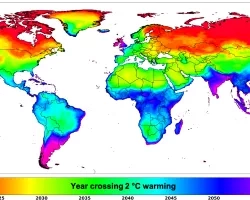NASA’s Applied Remote Sensing Training (ARSET) program equips participants with information about available NASA Earth observation data and tools, and how to apply them to a variety of topics including water, disasters, health and air quality, ecological forecasting, agriculture, and climate. Topics covered during trainings are determined through a blend of participant feedback and collaboration with the Earth science community.
ARSET will host a three-part series, “Atmospheric CO2 and CH4 Budgets to Support the Global Stocktake,” in May 2022, as a response to the Paris Climate Agreement beginning its first global stocktake (GST).
This three-part, introductory training will describe the Paris Climate Agreement’s objectives, introduce pilot products and equip participants with open-source information they can use to monitor, develop, and assess mitigation strategies specific to methane and carbon dioxide. The series will explore space-based, airborne, and ground-based measurements of carbon dioxide and methane as well as different methods for tracking their emission to and removal from the atmosphere. It will conclude with use cases at the country-level.
From the U.S. Environmental Protection Agency (EPA)
While there are a handful of different greenhouse gases, ARSET’s upcoming training will focus on methane and carbon dioxide. They are the most abundant greenhouse gases, and both pose a unique threat to global climate: methane is approximately 25x more potent as a greenhouse gas than CO2 over a 100 year period, but it doesn’t remain in the atmosphere as long as carbon dioxide does. Carbon dioxide may not be as potent as methane, but it resides in the atmosphere longer and is much more abundant. They each need tailored management and mitigation strategies to reduce their long- and short-term warming potential on the planet.
This webinar series is intended for stakeholders at local, regional, and national levels who are interested in managing greenhouse gas emissions to meet the goals of the Paris Agreement, national inventory developers, and researchers who are interested in developing top-down atmospheric greenhouse gas budgets. The skills taught in this training can be used to support the information gathering and assessment phases of the Stocktake, and help inform decision-makers to achieve a more transparent and complete GST. This training will also introduce participants to a dataset that can be applied to studies of the Earth’s natural carbon cycle and its response to human activity and a changing climate.
From the World Resources Institute
The first global stocktake began in late 2021 and is set to conclude in 2023. The stocktake process will be repeated on a 5-year cycle, and members will update their commitments accordingly after each cycle. The Stocktake itself consists of three phases: in the first phase, member countries gather and report updated emissions information. The second phase involves meetings to review and synthesize this information, and the third phase will use the collected information to develop plans for the future.
The global stocktake will not only help member countries collaborate to tackle the climate crisis, but will update the global community on the progress that has been made and the work that still needs to be done to mitigate the impacts of human-caused climate change and limit global warming. The information gathered from the current stocktake will be used to inform the next steps countries decide to take when they update their commitments to the Agreement, or Nationally Determined Contributions (NDCs), in the future.
Registration for this ARSET training is now open. Trainings are offered virtually and at no cost to participants, with synchronous and asynchronous training options available.



